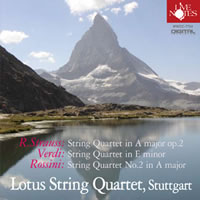
TEL : +81(0) 72 887 2560 / FAX : +81(0) 72 887 2561
[Tokyo-Office]1-24-7-408 Shinjuku Shinjuku-ku,Tokyo, 160-0022, Japan
TEL : +81(0) 3 5379 3733 / FAX : +81(0) 3 3353 6881
[KCM Ticket Service] +81(0) 570 00 8255
[KCM Artist Service] +81(0) 90 3727 6539
| Lotus String Quartet R.Strauss/Verdi/Rossini: String Quartets Review | |||
 |
|||
| R. Strauss: String quartet Verdi: String quartet Rossini: Sonata No. 2 for Strings in A major (string quartet edition) Lotus Quartet [Live Notes (D) WWCC7754] Amazon |
|||
The Record Geijutsu July 2014 "Honourable mention for the Specially Selected Disc"
Akira TAKAHASHI Recommended
The Stuttgart-based Lotus Quartet, who have continued their activities in succession to the Melos quartet, have released a new recording which feature works of romantic period. The inclusion of the Strauss string quartet in A major is unusual, which makes this a valuable new recording indeed, and the Verdi string quartet in E minor is also a welcome release.
As the three composers featured on this disc were all active as composers of operatic works, it is interesting that the set list features the composers' works for string quartet. As can be gleaned from the title 'Opus 2', Strauss composed this A major quartet in 1880, showing that he had mastered the technique of writing absolute music even at the age of 16. Meanwhile, Verdi's string quartet work was written in 1873 over a one-month period during his sojourn to Naples.
A wonderful performance of all the works can be heard by the Lotus Quartet. In the Strauss' work, all four parts are performed clearly with beautiful tone, and at the same time a flowing and romantic passion characteristic of the late romantic period is also brought forth. The scherzo in the 2nd movement is delicately performed, and yet also a full-bodied performance. The sound of the four parts in the Verdi quartet work is beautiful, as a result of a tightly knit ensemble bringing forth a brisk performance. The Rossini work in A major is also performed in a free and easy manner, and is so charming that one would want to listen to the composer's other five works for strings.
Masazumi OHKI Honourable mention
This album, on the occasion of 150 years since the birth of Richard Strauss, shines a spotlight on his string quartet work which could be said to have long fallen into obscurity, where a feature of this album is not that the work is combined with the typically well-known works, but that it offers the quartet works of the major opera composers Strauss, and of course Verdi and Rossini. The Verdi work is rather well-known although it could be said that it does not appear so often on CDs, and meanwhile apart from Rossini's edition for string orchestra edition as well as the original quartet edition featuring a contrabass, the edition for the standard string quartet instrumental ensemble does not often appear in recordings. As a result, this album is quite a rare one.
Strauss composed his work, a major one requiring about 30 minutes of listening time, at the tender age of 16. It would not be fitting to say that this is an étude or a curiosity, as it is a fine piece of music which stands on its own. This work, where the first movement begins with a stunningly beautiful, and unparalleled freely and elegantly gushing motif, shows the Lotus Quartet at the top of their form giving a superb performance as a brisk ensemble without drowning in sweetness.
The performance of the Verdi work is also charming. It is not only beautiful, but the performers also deserve a 'bravo' for not letting bypass but rather capturing the sense of ripened maturity latent in the work. It can be said that the sound of this quartet is of the highest class. In the Rossini performance, with no lack of its vigorous full speed, the Lotus String Quartet takes care not to lose their characteristic meticulous expression.
Yoshiyuki ISHIDA [Recording critic]
A well-adjusted balance can be heard with a clear placement of the four instruments, resulting in a very natural feeling like a sense of unity as an ensemble and a sound well put and blended together. A transparent high sound with can also be heard with no acoustic exaggeration or muddle. The session recordings took place at Heidelberg in April, May and September 2013 in a large open space with no strong acoustic reflection, and with a superior SN ratio, there is a feeling of a natural, albeit not an active, sound. (Rating: 93)
| Artist News | Top Page |